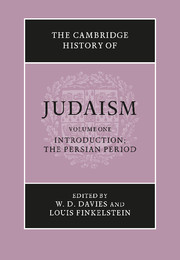Book contents
- Frontmatter
- INTRODUCTION
- THE PERSIAN PERIOD
- 4 The Persian empire and the political and social history of Palestine in the Persian period
- 5 The archeology of Persian palestine
- 6 Hebrew and Aramaic in the Persian period
- 7 The Jewish community in Palestine in the Persian period
- 8 Prophecy and Psalms in the Persian period
- 9 Wisdom literature in the Persian period
- 10 Jewish religious life in the Persian period
- 11 Persian religion in the Achemenid age
- 12 Iranian influence on Judaism: first century B.C.E. to second century C.E.
- 13 The Diaspora
- Bibliographies
- Chronological Table
- Index
- References
13 - The Diaspora
from THE PERSIAN PERIOD
Published online by Cambridge University Press: 28 March 2008
- Frontmatter
- INTRODUCTION
- THE PERSIAN PERIOD
- 4 The Persian empire and the political and social history of Palestine in the Persian period
- 5 The archeology of Persian palestine
- 6 Hebrew and Aramaic in the Persian period
- 7 The Jewish community in Palestine in the Persian period
- 8 Prophecy and Psalms in the Persian period
- 9 Wisdom literature in the Persian period
- 10 Jewish religious life in the Persian period
- 11 Persian religion in the Achemenid age
- 12 Iranian influence on Judaism: first century B.C.E. to second century C.E.
- 13 The Diaspora
- Bibliographies
- Chronological Table
- Index
- References
Summary
POLITICAL HISTORY
By the end of the seventh century b.c.e. only four major powers were left on the political map of the Near East: Egypt, Babylonia, Media and Lydia. In 550 the Persians, led by their king, Cyrus II, seized Media and over the next three years invaded Elam, Parthia, Hyrcania on the Caspian sea, and the whole of Asia Minor including Lydia and the Greek colonies. Between 545 and 539 b.c.e. Cyrus II conquered all the regions of Central Asia and Eastern Iran as far as the borders of India.
Following this, in the spring of 539 b.c.e. the Persian army attacked Babylonia and began to advance down the Diyala river valley. At this critical point, Ugbaru, the governor of Gutium (a Babylonian province to the east of the middle course of the Tigris) went over to Cyrus.
All the efforts of Nabonidus, the king of Babylonia, to resist the Persian advance proved doomed to failure. It was in the interests of Babylonia's merchants for an enormous empire to be created which would guarantee them a market and safe trading routes to Egypt, Asia Minor and other countries of the east, and they were therefore prepared to collaborate with the invaders. Influential priestly groups were also dissatisfied with Nabonidus. Although he continued to worship the ancient Babylonian gods Marduk, Nabu and their companions, he gradually began to promote the cult of the Moon god, Sin. Moreover, the Moon god whom Nabonidus patronized was not the traditional god Sin, but one whose symbols and forms of worship were more reminiscent of Aramaic deities.
- Type
- Chapter
- Information
- The Cambridge History of Judaism , pp. 326 - 400Publisher: Cambridge University PressPrint publication year: 1984
References
- 4
- Cited by



